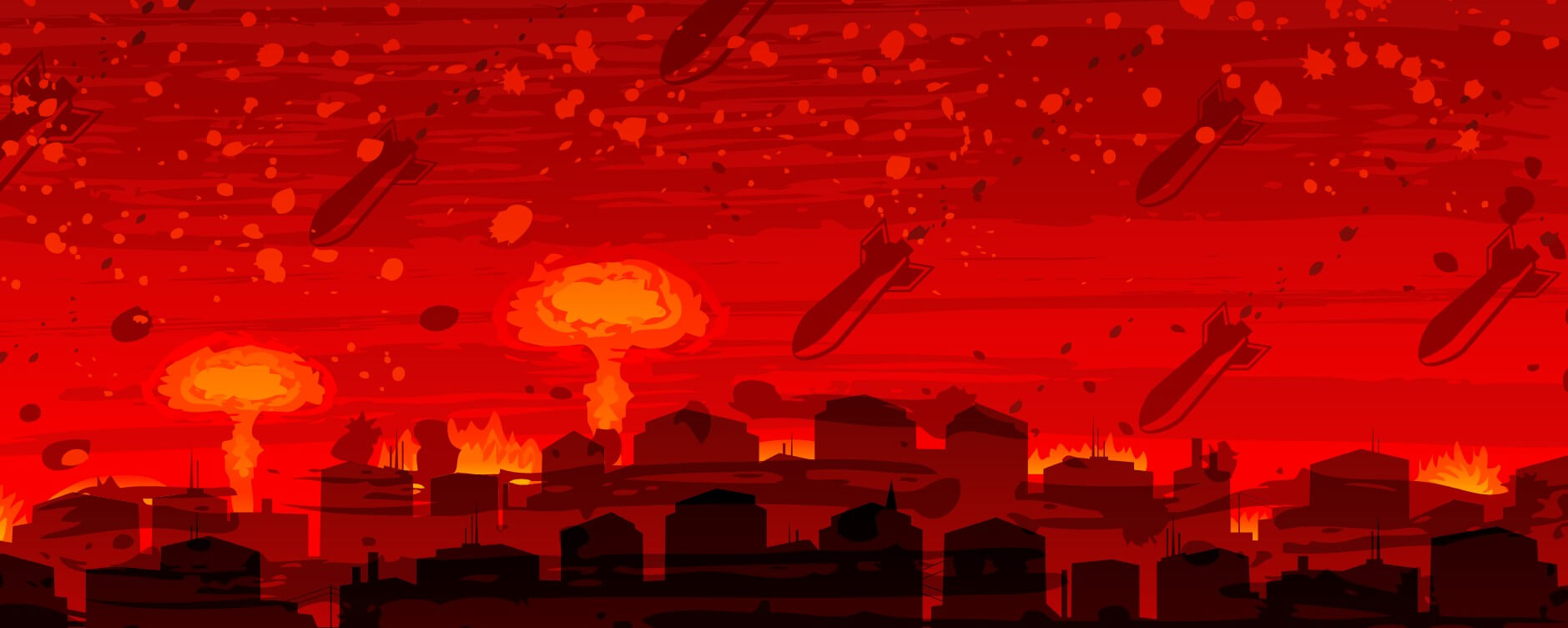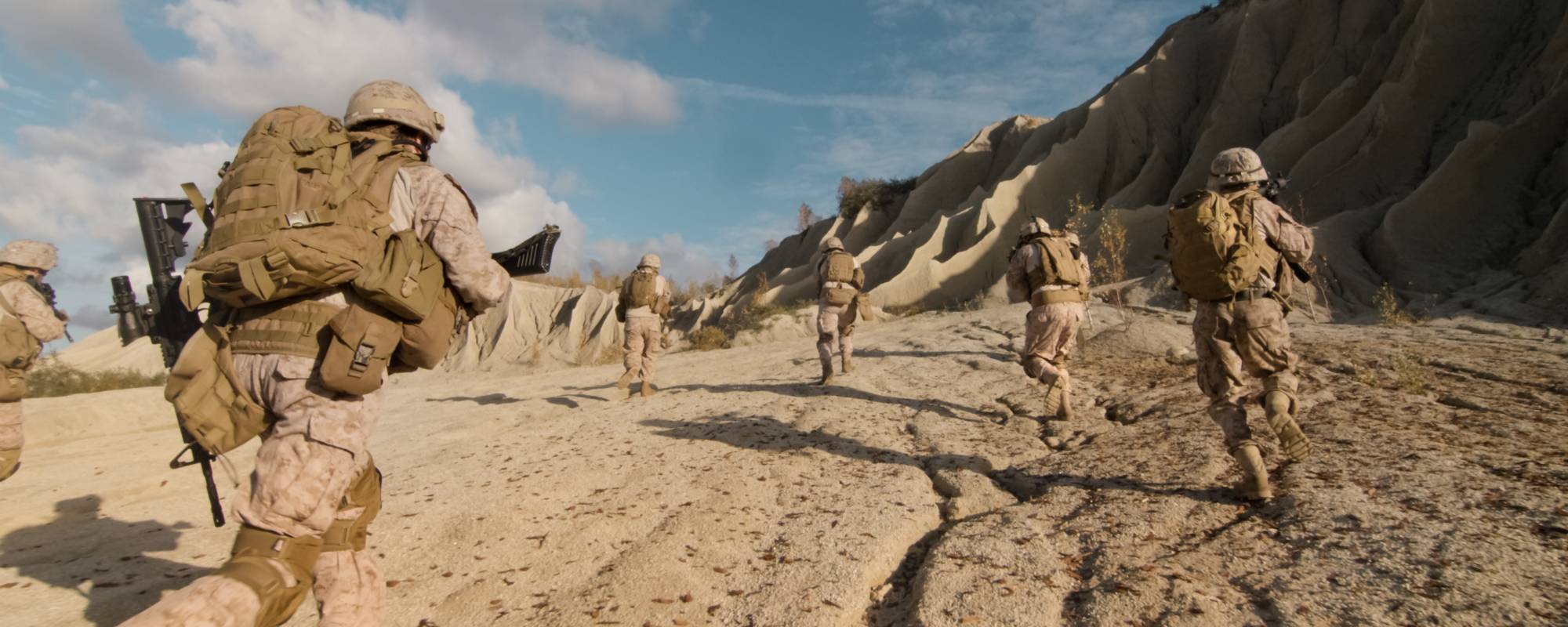While western militaries have often expressed a preference for rapid, decisive victories, rapidly achieving military objectives does not guarantee the achievement of political objectives.[1] I argue that a doctrine that narrows the range of methodologies commanders can use to achieve policy ends is antithetical to operational art, which involves innovative, flexible, strategically informed thinking.
Decisive Battle and Western Operational Art
The term decisive is sometimes treated as a synonym for rapid, or efficient, but these are three separate concepts. Decisive can mean rapid but can also mean leading to a decision – a lasting settlement.[2] This may be achieved through a single “decisive” battle, or through an attritional process that progressively develops the conditions for a decisive outcome. Carl von Clausewitz wrote that war is “an act of force to compel our enemy to do our will”,[3] and “the continuation of politics with other means.”[4] The threshold measure of success for a military campaign is therefore whether it convinces the adversary to accept a—preferably enduring—political settlement. Since war is costly in lives and other resources, it is true that one should spend no more resources than necessary to achieve the objective. But neither should one spend less than necessary, as resources spent without achieving an objective are always wasted. Seeking rapid battlefield victory is sometimes, but not always, possible or desirable. Since costs and risks accumulate the longer a force is in the field, an actor with an overwhelming advantage will usually be well advised to press that advantage to achieve a rapid victory. Conversely, the weaker party will benefit from delaying this decisive outcome. Clausewitz noted that “the defensive form of warfare is intrinsically stronger than the offensive”, as “it is easier to hold ground than to take it”.[5] During an attack “the force of the attack gradually diminishes” until the weaker party achieves the conditions to take the offensive.[6] In short, even when a rapid, decisive battlefield action is possible, the operational artist should be prepared for other possibilities, recognising that the enemy also has a say.
Much of contemporary western military doctrine embraces rapid, decisive manoeuvre action in operations, eschewing slower forms of warfare, and there is sometimes a tendency to assume conventional military success will naturally produce the desired political ends. In the late 1970s, a new school of manoeuvrist military theory arose, primarily in the US, championed by strategists such as Steven Canby, William Lind, and Edward Luttwak.[7] This was a reaction to the simplistic attrition theory NATO was deploying in Northern Europe, Manoeuvre theory, modelled on German blitzkrieg, was highly focused on the operational level of war, and advocated an audacious use of highly mobile, precise systems targeting enemy points of weakness such as command and control.[8] Luttwak embraced MacArthur’s “brilliant” Inchon landing, ignoring the fact that MacArthur’s manoeuvrist approach led to the strategically disastrous entry of China into the Korean War and one of the worst reverses in US military history.[9] The retreat was only salvaged by Matthew Ridgway’s patient, methodical attrition campaign. Manoeuvre theory became increasingly popular in the 1980s, and the US Marine Corps adopted it as its warfighting doctrine in 1989.[10] It has subsequently been adopted by other western militaries, including the Australian Army.[11] Later models, such as the Revolution in Military Affairs, similarly emphasise fast, dislocating and decisive methods. It is perhaps unsurprising that military thinkers in western democracies, accustomed to enjoying the economic, technical, and—in America’s case—numerical advantage over adversaries, should prefer rapid, decisive effects. Their forces are more expensive to keep in the field, and fickle public opinion can turn against a long war.[12] However, scholars such as Avi Kober have challenged these assumptions, arguing that wealthy western-style democracies such as Israel can and have successfully sustained both rapid and attritional wars.[13] This is important because it supports the development of a wide range of operational options, supporting effective operational art.
Manoeuvrist Mythology and Israeli-Egyptian Wars
Israel’s rapid advance to the Suez Canal during the Six Day War of 1967 is lauded by manoeuvre warfare advocates as a quintessential example of rapid, “decisive” operations, but it failed to be politically decisive.[14] The war followed two years of steady escalation, with guerrillas supported by Syria attacking Israel regularly across the Syrian and Jordanian borders, and Israel conducting reprisal incursions into those countries.[15] In May-June 1967, Arab troops began massing on Israel’s borders. Multiple Arab leaders publicly stated their intention to destroy the state of Israel.[16] On 5 June, Israel launched a rapid pre-emptive attack which emphasised mobility and precision. Israeli jets destroyed hundreds of enemy aircraft on the ground, while Israeli armour quickly overran Arab forces, seizing vast swathes of strategically important territory and forcing an Arab surrender by 10 June.[17] This strikingly rapid and comprehensive military victory has been hailed by manoeuvre warfare advocates such as John Antal as an example of blitzkrieg-style decisive military success. Antal even argues that “[t]he Israelis knew that they could not win a war of attrition against their Arab enemies” and they therefore adopted a strategy that “sought to bring about the defeat of their enemies in the minimum amount of time”.[18] However, while the war was militarily impressive and achieved security gains, it was not politically decisive, and it was followed by a war of attrition which, contra Antal, Israel won.[19]
The Six Day War demonstrated Israel’s military superiority in high-intensity conflict while imposing borders that Egyptian President Gamal Abd-el Nasser could not politically accept. This led him to resort to a low-intensity War of Attrition in hopes of forcing a political settlement by wearing Israel out.[20] There is a common intuition that democracies and economically advanced states are less resilient to long, attritional warfare than are authoritarian Third World countries.[21] This was an intuition shared by Nasser and Israeli leaders, but was proven wrong. Israel proved unexpectedly resilient, maintaining operations for an extended period, systematically dismantling Egypt’s air defence systems, and striking deep inside Egypt.[22] It was not until the Soviets provided their latest aircraft and air defence systems that conditions were set for a ceasefire, and even then, Egypt did not achieve its political objective of compelling Israel to withdraw from occupied territories.[23] This was another politically indecisive war for both sides.
It was not until the 1973 Yom Kippur War that a political settlement became possible, in a war that contradicted the presumed link between speed, military decisiveness and political decision. The two previous wars had convinced Nasser’s successor as Egyptian President, Anwar Sadat, that Israel’s air dominance and technical lead meant it was not going away.[24] However, the Egyptian people would not accept a peace that formalised the humiliating 1967 ceasefire line, and Israel had no incentive to bargain.[25] Egypt partnered with Syria to launch a conventional surprise attack on Israel, mirroring the Six Day War. They initially made rapid advances against the unprepared Israelis, using tanks, helicopters and paratroopers to bypass Israeli positions and attack Israeli command and control.[26] However, after this initial phase, the Egyptian advance stalled as the war entered a holding phase, and military culture became critical.
While the Arab militaries followed Soviet doctrine rigidly and employed centralised command, the Israelis allowed lower-level commanders autonomy to plan and execute operations adaptively, employing operational art at all levels.[27] This gave the Israelis the advantage during the counter-attack and they pushed the Egyptians back, crossing the Suez and denying the Egyptians a decisive military victory.[28] Lind identifies this as an example of the effectiveness of manoeuvre warfare, and argues that “Had the superpowers not intervened, this maneuver might well have enabled the Israelis to achieve their war aim of restoring the Suez Canal as the cease-fire line.” Nonetheless, while this was a military defeat for Egypt, it achieved Sadat’s political objective, demonstrating that Israel would not have peace until it negotiated acceptable terms, thus setting the conditions for a lasting peace agreement.[29] Sadat’s use of military operations to achieve political ends was astute “operational art” at the strategic level.[30] In the three wars, it was not any one factor – surprise, mobility, attrition, technological supremacy, or even battlefield victory – which was most efficient. Rather, during these three wars, both Israel and Egypt practiced effective operational art in adapting diverse methods of war to promote their political ends.
Iraq: Indecisive Blitzkriegs
Operation Desert Storm in 1991 was a striking demonstration that western technological dominance harnessed to a doctrine influenced by manoeuvre warfare could deliver rapid and overwhelming battlefield victory, achieving carefully defined political objectives. The coalition invasion began with a comprehensive, 37-day air war that systematically dismantled Iraqi air defence systems, airstrips, command and control and logistics, then pounded the Iraqi ground forces in a barrage that destroyed materiel, manpower and morale.[31] This was followed by a 100-hour lightning-fast land phase that routed the Iraqi military, regarded as the fourth-largest land force in the world at the time.[32] At the operational level, the coalition effort was a prudent use of military force to achieve realistic political objectives, which were to expel Iraq from Kuwait and restore the legitimate Kuwaiti Government, safeguard regional stability, and if possible to end Iraq’s weapons of mass destruction programs.[33] The US-led operation was also tactically brilliant in many ways. However, like the Six Day War, the short, sharp victory over Iraq left a legacy of unresolved political problems.
Military historian Michael Howard observed that the Gulf War was not strategically decisive – victory on the battlefield did not lead to a lasting peace. Using the war as a case study in assessing when wars are decisive, he posited three criteria. The first two criteria were met in the case of Iraq: a convincing military victory ended the immediate conflict, and the regime was isolated from international supporters who might “reverse the verdict”. The third criterion, however, was establishing a new government willing to “enforc[e] the peace-terms on its compatriots.”[34] Iraqi dictator Saddam Hussein remained in power and continued to menace his neighbours and his own population. He continued to sponsor terrorist movements and was often uncooperative with United Nations weapons inspectors, leading to lingering suspicions that he maintained a secret weapons program.[35] America found itself maintaining a large troop presence and no-fly zones to maintain regional security in the face of Iraqi intransigence, and its sanctions regime became increasingly controversial.[36] American policymakers increasingly saw Iraq as unfinished business.[37] Nonetheless, the intoxicating military victory of Desert Storm seemed to vindicate the military doctrine used. Military studies professor Antilio Echevarria argues that as the Cold War ended in 1991, western militaries should have developed a diverse range of adaptable operational options to deal with expected unpredictability in the strategic environment, but instead further refined methodologies they had already mastered.[38] This led to concepts such as the Revolution in Military Affairs and Network Centric Warfare, and to an optimism that caused coalition nations to underestimate the challenges of the 2001 Afghanistan War and 2003 Iraq War.[39]
When the US led a coalition to topple Saddam Hussein in 2003, their expectations of a speedy and decisive victory were rebutted by a bloody civil war for which they were completely unprepared. The coalition had several political objectives, including resolving the political legacies of the 1991 Gulf War and removing a known state sponsor of terrorism in the wake of the September 11 attacks.[40] The US approach, dubbed “shock and awe”, defeated the Iraqi government in less than three weeks with one third the forces used in the 1991 Gulf War, apparently vindicating the Revolution in Military Affairs.[41] However, no sooner had US President George W. Bush declared “Mission Accomplished” than multiple non-state actors and state proxies began an insurgency that soon escalated into a civil war.[42] The coalition lacked the personnel, the equipment and most importantly the doctrinal framework to mount a counterinsurgency.[43] In retrospect, this insurgency should have been predictable; having seen the 1991 Gulf War, the coalition’s adversaries were not about to form static defence positions in the desert again. Instead, they initiated an attritional war in the cities. The insurgents eroded the coalition’s technological advantage by adopting networked technologies themselves, and by operating in an environment that rendered aerial surveillance and tank battles irrelevant. [44] Far from disrupting terrorism, the invasion created the conditions for Iraq to become a breeding-ground for transnational Islamist terrorist groups. After three years of chaos and bloodshed, President Bush appointed General David Petraeus to command in Iraq, and Petraeus immediately began developing a new operational plan, the Surge.[45] Although Petraeus’ plan made use of technology, at its core was a people-centric operational concept that drew on long-neglected counterinsurgency doctrine. That it took three years for the US force to develop a coherent plan to counter the insurgency demonstrates that operational art had been smothered at many levels due to the narrow focus on operational concepts that promised to deliver rapid, cost-free victory. Once the insurgents had exercised their “vote” and generated an attritional conflict, new, flexible, critical thinking was needed at all levels.
These lessons are particularly important in the rapidly changing contemporary strategic environment. While western strategic thinking has developed against the background of unchallenged western technical dominance and, since 1991, predominant US force, these conditions can no longer be assumed in a multipolar world. Countries such as Russia and China that historically employed Soviet military technology and doctrine have modernised since 1991.[46] The growing power of large, very populous states means that, unlike the 1991 Gulf War, inter-state competition and conflict is likely to be characterised by greater geographical depth and mass, so wars are unlikely to be settled by a single decisive battle.[47] In addition, both Russia and China have developed grey-zone, hybrid or “new generation” warfare techniques that seek to avoid escalation to conventional warfare, circumventing potentially decisive battlefield engagements.[48] At the same time, non-state threats like terrorism and organised crime have not gone away. In this new world, western nations that seek to develop a prescriptive doctrine that favours one operational method over all others may struggle to respond appropriately to developments. A doctrine based around adaptive, iterative planning, flexibility and critical thinking, which recognises the enduring nature of war, and which is politically and strategically aware, is more suited to this uncertain strategic environment.[49] In short, operational art is more important than ever.
Aker, Frank. October 1973: The Arab-Israeli War. Hamden Connecticut: Archon Books, 1985.
Antal, John F. “Maneuver versus Attrition: A Historical Perspective.” Military Review 72, no. 10 (October 1992): 21–33.
Australian Government. “ADDP 3.0 Campaigns and Operations.” AL1 Ed 2. Operations Series. Canberra: Commonwealth of Australia, 2013.
———. Land Warfare Doctrine 1: The Fundamentals of Land Power 2017. Canberra: The Australian Army, 2017.
Babbage, Ross. Winning Without Fighting: Chinese and Russian Political Warfare Campaigns and How the West Can Prevail. Washington DC: Center for Strategic and Budgetary Assessments, 2019.
Bar-Siman-Tov, Yaacov. The Israeli-Egyptian War of Attrition 1969-1970. New York: Columbia University Press, 1980.
Bensahel, Nora. “Mission Not Accomplished.” In War in Iraq: Planning and Execution, edited by Thomas G. Mahnken and Thomas A. Keaney. London: Routledge, 2007.
Berzins, Janis. Not “Hybrid” but New Generation Warfare. Russia’s Military Strategy and Doctrine, 2019.
Betz, David J. “The More You Know, the Less You Understand: The Problem with Information Warfare.” Journal of Strategic Studies 29, no. 3 (2006): 505–33. https://doi.org/10.1080/01402390600765900.
Biddle, Tami Davis. “Air Power Theory: An Analytical Narrative from the First World War to the Present.” In Theory of War and Strategy, edited by J. Boone Bartholomees, Vol. I. Strategic Studies Institute, US Army War College, 2010.
Bin, Alberto, Richard Hill, and Archer Jones. Desert Storm: A Forgotten War. Westport Connecticut: Praeger, 1998.
Brands, Hal. “The Promise and Pitfalls of Grand Strategy.” Strategic Studies Institute , US Army War College, 2012.
Canby, Steven. “Mutual Force Reductions: A Military Perspective.” International Security 2, no. 3 (1978): 122–35.
Clausewitz, Carl von. On War. Edited by Michael Howard and Peter Paret. Oxford: Oxford University Press, 2008.
———. “Vom Kriege.” www.clausewitz.com. Accessed February 19, 2020. https://www.clausewitz.com/readings/VomKriege1832/_VKwholetext.htm.
Cordesman, Anthony H. “Strategic Lessons of the Conflict.” In The Lessons of Modern War: The Gulf War, 4:1026–54. Center for Strategic & International Studies, 1994.
Dunnigan, James F., and Austin Bay. From Shield to Storm: High-Tech Weapons, Military Strategy, and Coalition Warfare in the Persian Gulf. New York: William Morrow and Company, 1992.
Echevarria, Antulio J. “Rediscovering US Military Strategy: A Role for Doctrine.” Journal of Strategic Studies 39, no. 2 (2016): 231–45. https://doi.org/10.1080/01402390.2015.1115035.
Evans, Michael. “Reflections on an American Seer: Andrew W. Marshall and the Mind of the Strategist.” Australian Journal of Defence and Strategic Studies 1, no. 1 (2019): 99–112.
Feith, Douglas J. War and Decision: Inside the Pentagon at the Dawn of the War on Terrorism. New York: Harper, 2008.
Golan, Shimon. “The Yom Kippur War.” In Never-Ending Conflict: Israeli Military History, edited by Mordechai Bar-On. Mechanicsburg Pennsylvania: Stackpole Books, 2004.
Hiro, Dilip. Iraq: A Report from the Inside. London: Granta Books, 2002.
Holmes, James R. “Everything You Know About Clausewitz Is Wrong.” The Diplomat, 2014. https://thediplomat.com/2014/11/everything-you-know-about-clausewitz-is-wrong/.
Howard, Michael. “When Are Wars Decisive?” Survival 41, no. 1 (1999): 126–35. https://doi.org/10.1093/survival/41.1.126.
Johnston, Paul. “The Myth of Manoeuvre Warfare: Attrition in Military History.” In The Changing Face of War: Learning from History, edited by Allan D. English. Montreal: Royal Military College of Canada/McGill-Queen’s University Press, 1998.
Khalidi, Ahmed S. “The War of Attrition.” Journal of Palestine Studies 3, no. 1 (1973): 60–87.
Kilcullen, David. “Blood Year: Terror and the Islamic State.” Quarterly Essay. Melbourne, 2015.
Kober, Avi. “From Blitzkrieg to Attrition: Israel’s Attrition Strategy and Staying Power.” Small Wars and Insurgencies 16, no. 2 (2005): 216–40. https://doi.org/10.1080/09592310500080005.
Lind, William S. “Military Doctrine, Force Structure, and the Defense Decision-Making Process.” Air University Review XXX, no. 4 (1979): 21–27.
Loo, Bernard Fook Weng. “Decisive Battle, Victory and the Revolution in Military Affairs.” Journal of Strategic Studies 32, no. 2 (2009): 189–211. https://doi.org/10.1080/01402390902743118.
Luttwak, Edward N. “The Operational Level of War.” International Security 5, no. 3 (1980): 61–79.
O’Ballance, Edgar. The Electronic War in the Middle East 1968-70. London: Faber and Faber, 1974.
Olsen, John Andraes. A History of Air Warfare. Edited by John Andraes Olsen. Washington DC: Potomac Books, 2010.
Oren, Michael. “The Six Day War.” In Never-Ending Conflict: Israeli Military History, edited by Mordechai Bar-On. Mechanicsburg Pennsylvania: Stackpole Books, 2004.
Pollack, Kenneth M. “The Fall and Rise and Fall of Iraq.” Middle East Memo, no. 29 (July 2013).
Record, Jeffrey. Hollow Victory: A Contrary View of the Gulf War. Washington DC: Brassey’s, 1993.
Rikhye, Indar Jit. The Sinai Blunder: Withdrawal of the United Nations Emergency Force Leading to the Six-Day War of June 1967. London: Frank Cass, 1980.
Ritter, Scott. Endgame: Solving the Iraq Crisis. New York: Simon & Schuster, 1999.
Sargeant, Brendan. “White Paper Trails: Why Defence Cooperation Still Matters.” Asia Society, 2019.
Schueftan, Dan. “The Israeli-Egyptian ‘War of Attrition,’ 1969-1970.” In Never-Ending Conflict: Israeli Military History, edited by Mordechai Bar-On. Mechanicsburg Pennsylvania: Stackpole Books, 2004.
Tessler, Mark. A History of the Israeli-Palestinian Conflict. Indiana Series in Arab and Islamic Studies. Bloomington: Indiana University Press, 1994.
United States Government. “China Military Power: Modernising a Force to Fight and Win.” United States Defense Intelligence Agency, 2019.
———. “Joint Publication 5-0: Joint Planning,” June 16, 2017.
United States Government Department of the Navy. “FMFM 1 Warfighting.” Washington DC: United States Government, 1989.
White, Hugh. “Northern Exposure: What the Rise of Indonesia Means for Australia.” The Monthly, June 2013.
———. The China Choice: Why We Should Share Power. Oxford: Oxford University Press, 2012.
Assignment in Confidence
[1] Bernard Fook Weng Loo, “Decisive Battle, Victory and the Revolution in Military Affairs,” Journal of Strategic Studies 32, no. 2 (2009): 189, https://doi.org/10.1080/01402390902743118.
[2] Paul Johnston, “The Myth of Manoeuvre Warfare: Attrition in Military History,” in The Changing Face of War: Learning from History, ed. Allan D. English (Montreal: Royal Military College of Canada/McGill-Queen’s University Press, 1998), 29.
[3] Carl von Clausewitz, On War, ed. Michael Howard and Peter Paret (Oxford: Oxford University Press, 2008), 13.
[4] Clausewitz, On War, 7. Although sometimes mistranslated as “by other means”, the original text, “Der krieg ist eine bloße Fortsetzung der Politik mit anderen Mitteln”, uses the word “mit”, meaning “with” in each place where this phrase occurs; Carl von Clausewitz, “Vom Kriege,” www.clausewitz.com, accessed February 19, 2020, https://www.clausewitz.com/readings/VomKriege1832/_VKwholetext.htm. See also; James R. Holmes, “Everything You Know About Clausewitz Is Wrong,” The Diplomat, 2014, https://thediplomat.com/2014/11/everything-you-know-about-clausewitz-is-wrong/.
[5] Clausewitz, On War, 159–60.
[6] Clausewitz, On War, 198.
[7] Steven Canby, “Mutual Force Reductions: A Military Perspective,” International Security 2, no. 3 (1978): 125–27; William S. Lind, “Military Doctrine, Force Structure, and the Defense Decision-Making Process,” Air University Review XXX, no. 4 (1979): 22–25; Edward N. Luttwak, “The Operational Level of War,” International Security 5, no. 3 (1980): 63–66.
[8] Luttwak, “Operational Level of War,” 61, 65–68.
[9] Hal Brands, “The Promise and Pitfalls of Grand Strategy” (Strategic Studies Institute , US Army War College, 2012), 27; Luttwak, “Operational Level of War.”
[10] United States Government Department of the Navy, “FMFM 1 Warfighting” (Washington DC: United States Government, 1989), 58.
[11] Australian Government, Land Warfare Doctrine 1: The Fundamentals of Land Power 2017 (Canberra: The Australian Army, 2017), 31–33.
[12] Avi Kober, “From Blitzkrieg to Attrition: Israel’s Attrition Strategy and Staying Power,” Small Wars and Insurgencies 16, no. 2 (2005): 218–19, https://doi.org/10.1080/09592310500080005.
[13] Kober, “From Blitzkrieg to Attrition,” 235.
[14] Ahmed S. Khalidi, “The War of Attrition,” Journal of Palestine Studies 3, no. 1 (1973): 61.
[15] Indar Jit Rikhye, The Sinai Blunder: Withdrawal of the United Nations Emergency Force Leading to the Six-Day War of June 1967 (London: Frank Cass, 1980), 4–5, 8.
[16] Rikhye, The Sinai Blunder, 9, 16–17, 23, 60, 85–86, 95–96; Mark Tessler, A History of the Israeli-Palestinian Conflict, Indiana Series in Arab and Islamic Studies (Bloomington: Indiana University Press, 1994), 392–93.
[17] Tessler, History of the Israeli-Palestinian Conflict, 397, 399–401, 404; Rikhye, The Sinai Blunder, 143–47; Michael Oren, “The Six Day War,” in Never-Ending Conflict: Israeli Military History, ed. Mordechai Bar-On (Mechanicsburg Pennsylvania: Stackpole Books, 2004), 137–39, 141, 143, 145.
[18] John F. Antal, “Maneuver versus Attrition: A Historical Perspective,” Military Review 72, no. 10 (October 1992): 28.
[19] Shimon Golan, “The Yom Kippur War,” in Never-Ending Conflict: Israeli Military History, ed. Mordechai Bar-On (Mechanicsburg Pennsylvania: Stackpole Books, 2004), 159.
[20] Dan Schueftan, “The Israeli-Egyptian ‘War of Attrition,’ 1969-1970,” in Never-Ending Conflict: Israeli Military History, ed. Mordechai Bar-On (Mechanicsburg Pennsylvania: Stackpole Books, 2004), 150.
[21] Kober, “From Blitzkrieg to Attrition,” 222–23.
[22] Schueftan, “Israeli-Egyptian ‘War of Attrition,’” 153; O’Ballance, Electronic War in the Middle East, 97; Bar-Siman-Tov, Israeli-Egyptian War of Attrition, 98–99.
[23] O’Ballance, Electronic War in the Middle East, 114–15, 129–30.
[24] Schueftan, “Israeli-Egyptian ‘War of Attrition,’” 153.
[25] Michael Howard, “When Are Wars Decisive?,” Survival 41, no. 1 (1999): 128, https://doi.org/10.1093/survival/41.1.126.
[26] Frank Aker, October 1973: The Arab-Israeli War (Hamden Connecticut: Archon Books, 1985), 28–29, 80.
[27] Aker, October 1973, 82–84, 128.
[28] Golan, “Yom Kippur War,” 174–75.
[29] Golan, “Yom Kippur War,” 176.
[30] Tessler, History of the Israeli-Palestinian Conflict, 479.
[31] James F. Dunnigan and Austin Bay, From Shield to Storm: High-Tech Weapons, Military Strategy, and Coalition Warfare in the Persian Gulf (New York: William Morrow and Company, 1992), 145–49; Bin, Hill, and Jones, Desert Storm, 83, 91, 112–14; Tami Davis Biddle, “Air Power Theory: An Analytical Narrative from the First World War to the Present,” in Theory of War and Strategy, ed. J. Boone Bartholomees, vol. I (Strategic Studies Institute, US Army War College, 2010), 297–98; John Andraes Olsen, A History of Air Warfare, ed. John Andraes Olsen (Washington DC: Potomac Books, 2010), 177.
[32] Dunnigan and Bay, From Shield to Storm, 263–66; Jeffrey Record, Hollow Victory: A Contrary View of the Gulf War (Washington DC: Brassey’s, 1993), 57; Bin, Hill, and Jones, Desert Storm, 145.
[33] Bin, Hill, and Jones, Desert Storm, 53.
[34] Howard, “When Are Wars Decisive?,” 134.
[35] Scott Ritter, Endgame: Solving the Iraq Crisis (New York: Simon & Schuster, 1999), 33–35, 126; Dilip Hiro, Iraq: A Report from the Inside (London: Granta Books, 2002), 98–99; Douglas J. Feith, War and Decision: Inside the Pentagon at the Dawn of the War on Terrorism (New York: Harper, 2008), 223–27.
[36] Hiro, Iraq, 130–31, 134–35.
[37] Feith, War and Decision, 222–28.
[38] Antulio J. Echevarria, “Rediscovering US Military Strategy: A Role for Doctrine,” Journal of Strategic Studies 39, no. 2 (2016): 232, 235, https://doi.org/10.1080/01402390.2015.1115035.
[39] Loo, “Decisive Battle, Victory, Revolution in Military A,” 190; Echevarria, “Rediscovering US Military Strategy,” 237; David J. Betz, “The More You Know, the Less You Understand: The Problem with Information Warfare,” Journal of Strategic Studies 29, no. 3 (2006): 505–7, https://doi.org/10.1080/01402390600765900.
[40] Feith, War and Decision, 18–19.
[41] Michael Evans, “Reflections on an American Seer: Andrew W. Marshall and the Mind of the Strategist,” Australian Journal of Defence and Strategic Studies 1, no. 1 (2019): 109.
[42] Nora Bensahel, “Mission Not Accomplished,” in War in Iraq: Planning and Execution, ed. Thomas G. Mahnken and Thomas A. Keaney (London: Routledge, 2007), 129.
[43] Kenneth M. Pollack, “The Fall and Rise and Fall of Iraq,” Middle East Memo, no. 29 (July 2013): 1–2.
[44] Betz, “The More You Know, the Less You Understand,” 505, 514.
[45] David Kilcullen, “Blood Year: Terror and the Islamic State,” Quarterly Essay (Melbourne, 2015), 22.
[46] United States Government, “China Military Power: Modernising a Force to Fight and Win” (United States Defense Intelligence Agency, 2019), 2–4.
[47] Anthony H. Cordesman, “Strategic Lessons of the Conflict,” in The Lessons of Modern War: The Gulf War, vol. 4 (Center for Strategic & International Studies, 1994), 1037; Hugh White, The China Choice: Why We Should Share Power (Oxford: Oxford University Press, 2012), 56; Hugh White, “Northern Exposure: What the Rise of Indonesia Means for Australia,” The Monthly, June 2013, 30; Brendan Sargeant, “White Paper Trails: Why Defence Cooperation Still Matters,” Asia Society, 2019.
[48] Ross Babbage, Winning Without Fighting: Chinese and Russian Political Warfare Campaigns and How the West Can Prevail (Washington DC: Center for Strategic and Budgetary Assessments, 2019), 7–8; Janis Berzins, Not “Hybrid” but New Generation Warfare, Russia’s Military Strategy and Doctrine, 2019, 165–66.
[49] Echevarria, “Rediscovering US Military Strategy,” 232, 237.









Comments
Start the conversation by sharing your thoughts! Please login to comment. If you don't yet have an account registration is quick and easy.